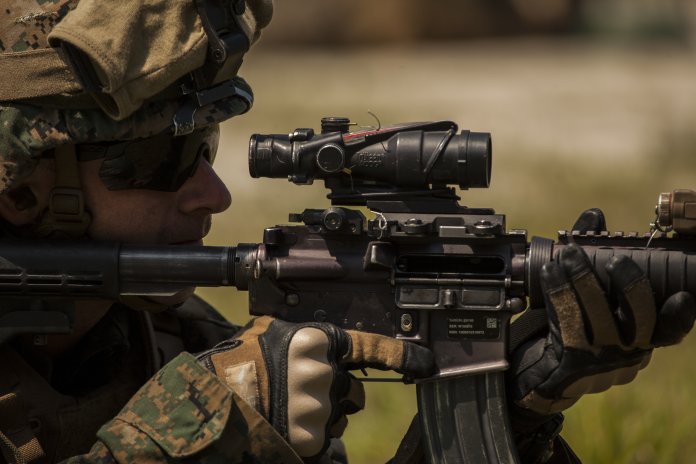
Variable magnification and laser range finding are two factors that have greatly improved weapon sighting for modern riflemen.
For much of history the primary focus of infantry firearms has been on improvements to the weapon and/or its ammunition. How these weapons are aimed has remained relatively unchanged with militaries relying on ‘iron sights’ well into the 1980s. Optical sights were generally limited to specially trained and tasked snipers or a designated marksmen of rifle squad/platoons. Still for most soldiers engaging a target was a skill learned through hours of training and practice on the range.
Red Dot
The shift to intermediate calibres like the 5.56mm and 5.45mm optimised for engagements inside 400 meters coincided with the development of projected reticle ‘reflex’ sights (often referred to as Red Dot), reflecting the earliest designer Aimpoint. These non-magnified sights allow almost intuitive aiming with both eyes open. The shooter needs to merely place the dot in the sight onto the target and pull the trigger. They, and the similar holographic sights, allow faster target acquisition and engagement, particularly between 50-300m ranges, with minimal training. The reflex sight has been widely adopted by armies worldwide.
The US Army began fielding the Aimpoint Comp M2 as the M68 Close Combat Optic in 2000 and it used by NATO, Russian Federation and China’s People’s Liberation Army (PLA) infantry. Manufacturers include the EOtech, Vortex, Trijion, Burris, Dagger Defense, Sig Sauer among others. Recently Meprolight introduced its MEPRO 2, a red-dot with a multi-pattern reticle that can be changed by the user based on the tactical situation.
Fixed Magnification – ACOG
The Advanced Combat Optical Gunsight (ACOG) was developed and first offered by Trijicom in 1987. A prismatic telescopic sight with fixed (typically 4x) magnification and projected reticle it offers acquisition using both eyes with improved target identification. The ACOG design is light weight, often below 400 grams, making it well suited for close quarters engagements to around 400-600 meters. It offers some capabilities of telescopic scope in a simpler and lower cost package. Its larger objective lens also collects ambient light which with tritium illuminated reticle provides improved low light aiming.
The benefits of the ACOG configuration have seen similar designs by other manufacturers including the Vortex Optics Spitfire. The design has been introduced into other militaries including the German Bundeswehr and Latvian with their G36 rifle, and by British, Irish, Finnish, and Spanish forces. Similar optics have also been fielded for the PLA’s QBZ-95 and Russian Federation’s AK-74 and AK-12.
A drawback of the ACOG is that the sight must be matched to the specific ballistic performance of the weapon it is used on. Thus, for example the M16A1 and M4, although both using the same 5.56mm ammunition, have different barrel lengths and thus different ballistics. As a result, two different TA11 ACOGs versions are required to account for the different trajectories despite their seeming identical appearance.
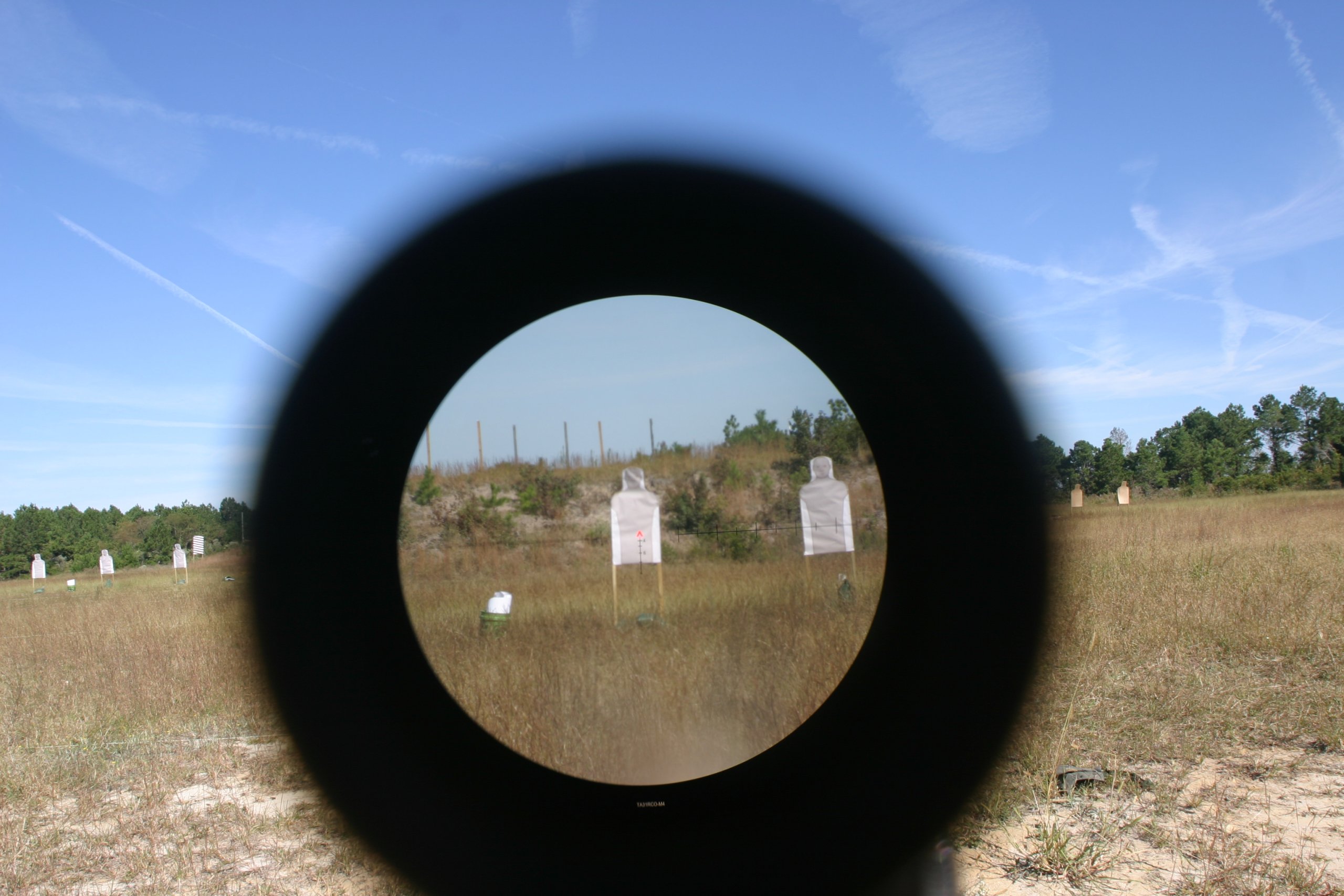
Variable Magnification
Traditionally magnified sights have been largely limited to specially trained rifleman designated to engage targets at extended ranges. The scopes, particularly variable magnification sights, were costly, required special handling and training. High magnification sights also have smaller field of view (FOV) meaning less area can be viewed through the scope. A lower magnification offers less detail but more surroundings (i.e. FOV) while a greater power shows more details but less surroundings. High magnification could be compared to ‘looking through a straw’. This is illustrated by comparing the 19 feet area seen at 5 power versus 3 feet at 30 power at the same range. It can be difficult to acquire a specific target. An advantage of a variable scope is the ability to select a lower magnification to search for a target and then switch to a more powerful setting to identify and engage. Advances in optics materials and improved manufacturing processes are providing more rugged scopes suited for broader soldier use.
The US Army is adopting a variable scope sight for the squad rifleman selecting the Sig Sauer TANGO6T scope. Called the Direct View Optic (DVO) this was already being used by the Army’s Squad Designated Marksman. TANG06T allows magnification from 1-6x power adjusted by the shooter. The DVO allows every rifleman to engage at greater ranges. The US Marine Corps have always stressed marksmanship (every Marine a rifleman) giving special attention to the sights used. When the Army adopted the Red-Dot, the Marines went a step further adopting a fixed optic in the ACOG. Now, in conjunction with fielding a new service rifle, the Heckler & Koch M27, they are moving to the Low-Power Variable Optic (LPVO). The system selected is a 1-8x variable-powered sight from Trijion designated the Squad Common Optic (SCO). It uses a milliradian front focal plane reticle that can be used on any rifle with a variety of ammunition. SCO will work on nearly every rifle or carbine and possible ammunition including current and near future.
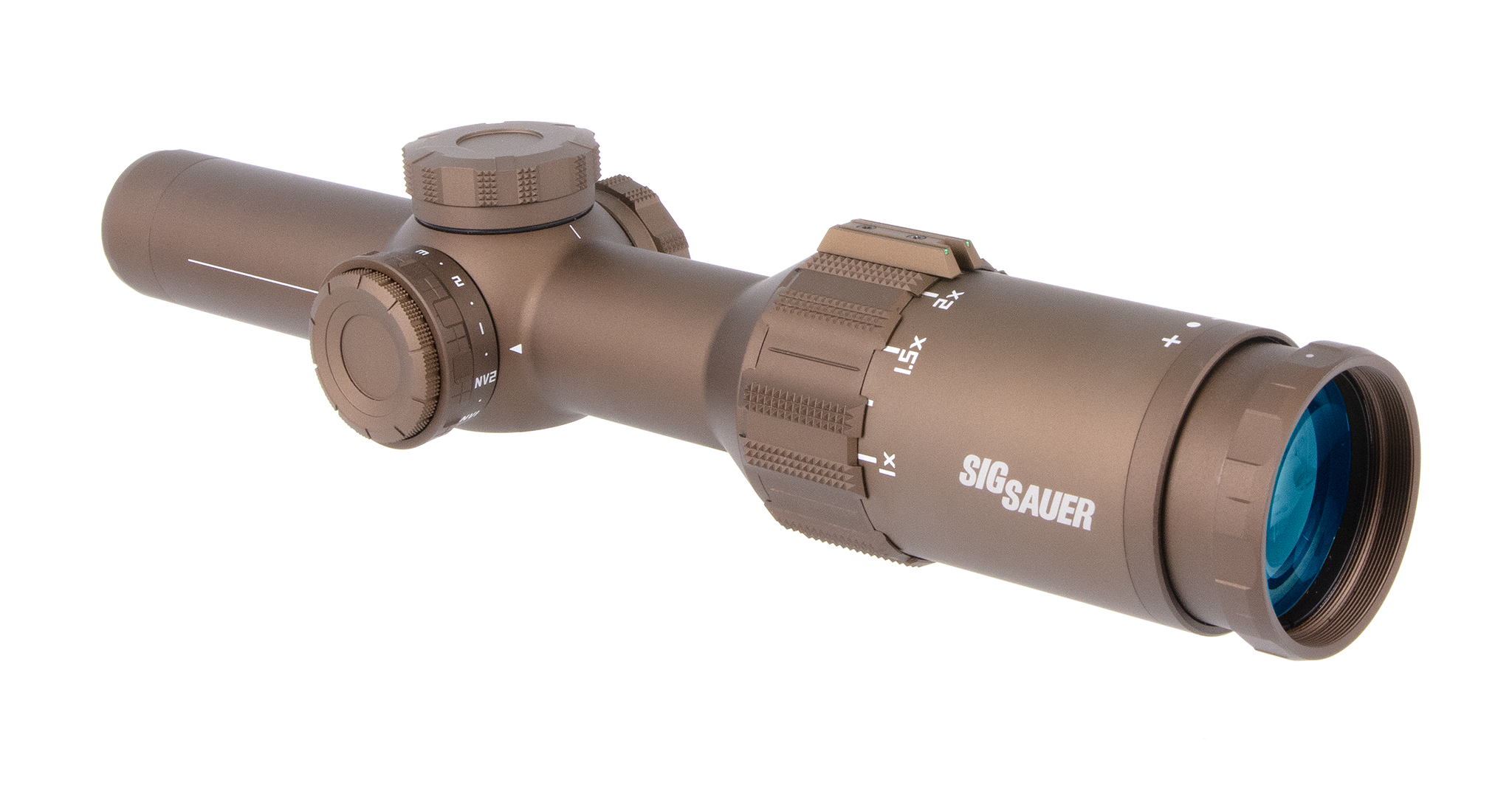
The variable scope facilitates the push by some militaries to enable engagements at ranges greater than 600m and more by the squad rifleman. Yet, it should still provide for engagements inside 300m in close terrain and urban areas. In addition, access to the higher magnification offers the benefits of improving visual reconnaissance and sound target identification. These scopes also lend themselves for use on multiple weapons within the squad or small unit thereby allowing for a common optic.
Leupold & Stevens and Aimpoint have come together to offer a sight that combines attributes of the variable magnification scope and the Red-Dot. Their ECOS-O (Enhanced Combat Optical Sight – Optimised has a Mark 6 3-18x scope and Micro T-1 red-dot aiming system. It offers both eyes shooting to 30m and optically enhanced targeting between 300-1000m. The package can be fitted to a range of combat rifles and used with mated grenade launchers. The sight was ordered by the US Navy Surface Warfare Center Crane with last deliveries in 2018.
The introduction and widespread inclusion of Picatinny or tactical rail systems on individual weapons has offered a new level of adaptability by providing mounting points for various accessories. Rails can be sited on the top, bottom or sides of the weapon allowing multiple devices to be mounted, used, and changed. Rails have become a standard feature on most combat arms.
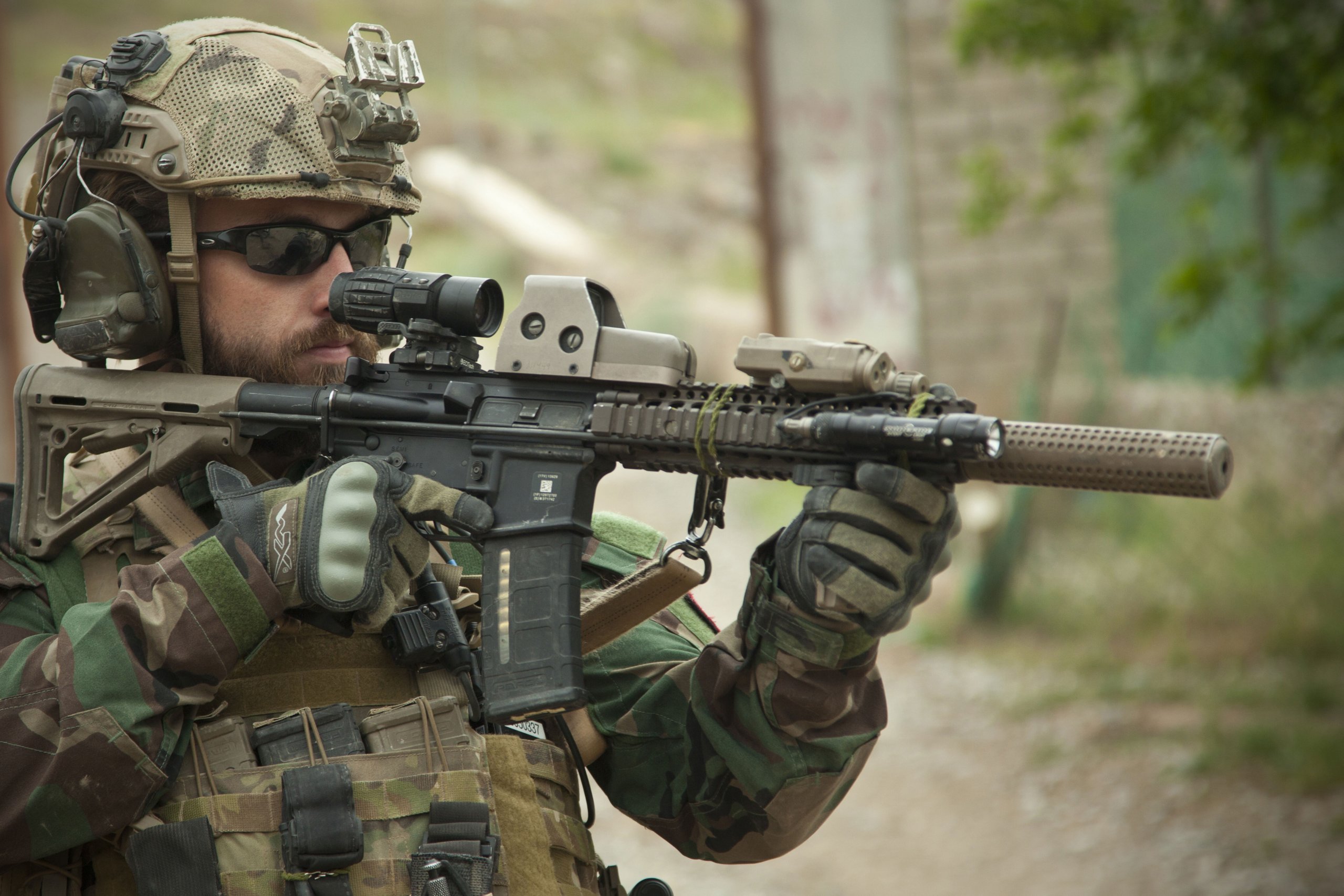
Compact Lasers
One of the most useful aids that can be rail mounted is the laser which can be used for range finding or aiming. With the latter, the laser’s ‘spot’ is adjusted to the bullet impact so that the shooter needs to simply place the spot onto the target and pull the trigger. Laser ranging provides the distance from the weapon to a target, information that is critical to reliably hitting a target, particularly as the range increases. Accurately knowing the range allows a shooter to compensate for the drop of the bullet caused by gravity and its loss of velocity. Today’s lasers using micro-electronics and digitalisation have become quite small. German optical technology firm Jenopik’s DLEM20 diode laser module, for example, is under 33 grams and is only 50mmx22mmx34mm in size yet has an accuracy of better than .5m for a man-size target at 2000m.
These advances have seen wide adoption of lasers on individual weapons. The key benefit of the laser sight is that it always indicates where the weapon’s muzzle is pointing allowing the shooter to get on target faster, an advantage in an unexpected engagement. It is also compatible with night vision goggles allowing the wearer to see the laser. It is not necessary to aim along the weapon as a target can be engaged by simply placing the “dot” on it. A laser dot, however, can be difficult to see at long ranges or in bright conditions, although green lasers are more visible than red lasers. They also generally do not provide for ballistic adjustment for windage and elevation tending to be zeroed for a set range. These attributes recommend the laser sight primarily where quick aiming at closer ranges is anticipated.
On the other hand, the laser rangefinder is a significant benefit for longer range shooting. Knowing the precise range to target is critical as the target distance increases. Smaller, lighter ranging devices can be mounted on virtually any weapon. The SAFRAN Optics 1 I-CUGR (Integrated Compact Ultralight Gun-Mounted Rangefinder) being fielded by the US Marines, is only 12 ounces (340g) with mount and battery and 152x71x45mm (6×2.8×1.8 inch). It provides not only accurate range of a man-sized target to 1300m and a vehicle to 2,500m, but also a visual or IR laser spot for aiming or target marking. Another is L3 Harris’s STORM (Small Tactical Optical Rifle-Mounted Micro Laser Rangefinder) being used by US Navy Special Operations. In addition to ranging and aiming, its digital magnetic compass allows display of a target geospatial coordinates. L3 Harris also offers a smaller lighter STORM-SLX. The price of laser rangers has reached a level that they are readily available and in wide use.
Rifle Fire Control Systems
A Fire Control System (FCS) is an aiming system that takes various data that effects the ability to hit a target and combines it to calculate and present the human operator with a firing solution that assures a hit. These factors can include range to target, ammunition type, wind, temperature, meteorological conditions and can include inputs like barrel wear and other data. The FCS has been a standard feature on tanks, artillery, and even for heavy crew served weapons. It has, despite many development efforts, been too large, heavy, and costly for practical rifleman use. But miniaturisation, digitisation, and computing advances have now combined to allow FCS packages suitable for individual small arms.
Steiner’s Intelligent Combat Sight (ICS) integrates a laser rangefinder and ballistic calculator in a compact, 788g (27.8oz) 6x scope that offers first round hits to 800m. This integration of functional elements provides significant benefits for shooter performance simply by combining the control of these in a single package. The ICS also automatically determines the necessary trajectory compensation based on the range input and displacing the aiming point in the optic. The shooter then only needs to place the aim-point on the target and fire. The sequence is simple and fast. Plus, the sight is extremely rugged being waterproof, fog proof and able to take a 750G shock. The company has also developed a sight with a built-in calculator and sensor suite and up to 28x power for extended 1000m+ range sniper engagements, the M7Xi 4 – 28x Intelligent Firing Solution.
Raytheon’s ELCAN Specter digital fire control sight integrates the rangefinder and ballistic calculator in a design that can be both adapted to the optical set-up as preferred by the customer and the specific weapon application. Mike Lewis, Rifle Sight Project Lead, explained that the Danish Army “selected our DR 1-4x for their rifles and light machine guns and our DR 1.5-6x for their heavy machine guns”. He added that the current design can accept up to “eight pieces of mission information including temperature, humidity, atmospheric pressure, range, weapon, ammunition, and weapon tilt, and reduces that down to a ballistic solution in a split second.” The adaptability and growth possibilities of Specter are illustrated by “our adding wireless communications and cameras to the sights to allow sharing of both images and information between units and command. Advanced software processing will also enable active target tracking and augmented reality capabilities.” Specter will also include a thermal night vision capability through the addition of devices like the TigIR thermal clip-on imager from Andres.
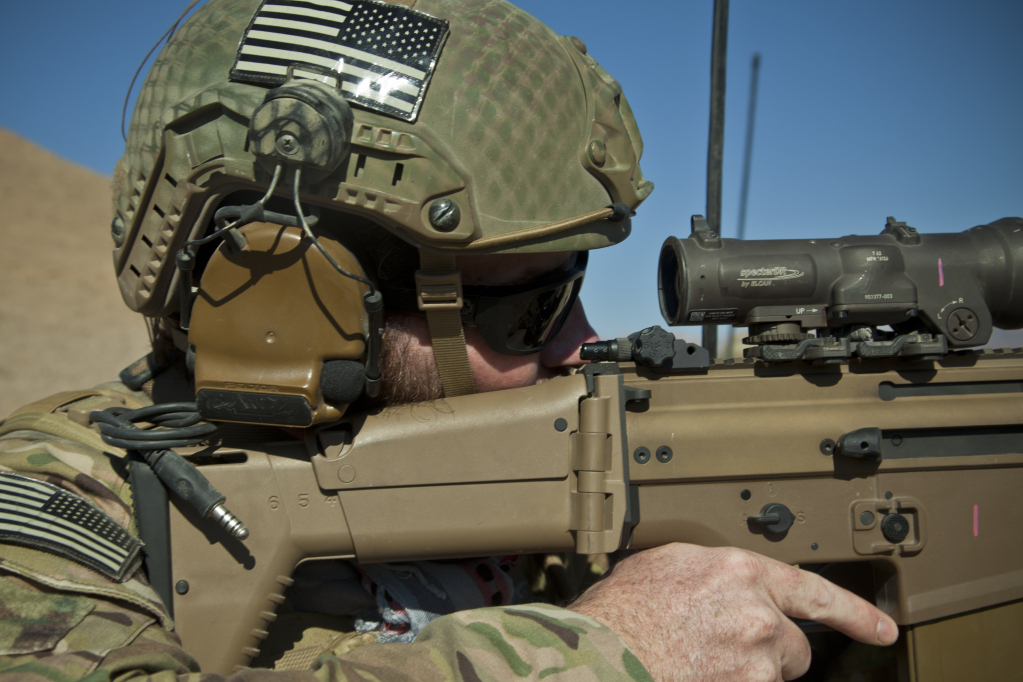
Vortex Optics and L3Harris have both been selected to provide advanced fire control sights for the US Army Next Generation Squad Weapons. In fact, their solutions outwardly appear similar. The Vortex uses a direct view 1-8x 30 variable power focal plane optic with an Active Reticle Fire Control, one kilometre laser rangefinder, on-board ballistic calculator, atmospheric sensor suite, and overlayed programable active-matrix micro-display. It has been described as a ‘red dot/1-8 Combo’. L3Harris has teamed with Leupold & Stevens for its Squad Fire Control (SFC) sight solution. It integrates the laser rangefinder, ballistic computation, inclination/cant and environmental sensors with a variable 1-6x optic to both increase accuracy and provide faster target engagement.
The direction of individual weapon sights is certainly linked to the availability of technology advances, with optics and electronics now packaged to accommodate most weapons. Recent combat experiences in Iraq and Afghanistan has influenced demands for increased engagement ranges including for the individual rifleman. There is also the challenge of determining how to make practical use of these capabilities given the realities of combat, where closer engagements often inside 200m can be more typical.
by Stephen W. Miller












